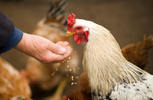
The Truth About Layer Pellets: What Are You Really Feeding Your Chickens?
, by Majella Gee, 38 min reading time

, by Majella Gee, 38 min reading time
(Ingredient breakdown + natural alternatives)
Walk into any feed store and you’re met with rows of glossy bags promising “premium nutrition,” “strong shells,” and “high-performing layers.” For most backyard chicken keepers — especially beginners — layer pellets feel like the safest, easiest choice. Scoop, pour, done.
But here’s the real question:
Do you know what’s actually in those pellets?
And just as importantly:
Is it what your hens truly need?
Let’s pull back the curtain on commercial feeds so you can make informed decisions for your flock.

What Exactly Are Layer Pellets?
Layer pellets are a processed, compressed feed designed for hens around 18–20 weeks and older. They typically aim for:
Convenient? Absolutely.
But like any processed product, the ingredients — and their quality — matter.
What’s Really Inside Layer Pellets?
(And why some ingredients may surprise you.)
Every brand varies, but most commercial layer pellets follow a similar formula.
1. Grain Base (Usually the Majority)
Common grains include:
Great energy sources, but quality varies dramatically between manufacturers. Cheaper feeds may contain:
You rarely know the ratios.
2. Soybean Meal (Primary Protein Source)
Used almost universally because it’s cheap and rich in protein.
Downsides many keepers are unaware of:
Not inherently harmful — but worth knowing.
3. Canola Meal or Other Oilseed Meals
Secondary protein sources. Again, inexpensive and widely used, though not a natural food for an omnivorous bird.
4. Limestone or Shell Grit (Calcium)
Essential for eggshell production.
But when calcium is mixed into pellets:
Always provide separate shell grit so hens can regulate their own intake.

5. Salt
Needed in tiny amounts — but harmful in excess. Commercial feeds regulate this closely.
6. Vegetable Oil
Added for:
Some brands use fresh, food-grade oil.
Others may use lower-quality or recycled oils (not ideal).
7. Synthetic Vitamins & Minerals
Pellets often include a synthetic premix so hens receive consistent micronutrients.
But these degrade quickly when:
If pellets smell stale, the vitamins have likely oxidised.
8. Animal Proteins (Sometimes Added)
Some brands boost protein with:
Quality varies widely.
Nothing wrong with animal protein — chickens are omnivores — but some keepers prefer to avoid rendered by-products.
9. By-Products & Fillers
Depending on the brand, you may see:
Safe, but not nutritionally meaningful.
10. Pelleting Agents (Binders)
This is one ingredient most keepers never consider.
Many pellets use bentonite clay or similar binders to hold the mash together.
Bentonite varies depending on its geological source.
Some clay deposits naturally contain trace contaminants such as:
Reputable manufacturers test these sources and choose cleaner deposits, but budget feeds may not follow the same standards.
Look for brands that:
Transparency is key.

Are Layer Pellets “Bad”?
Not at all.
They offer:
✔ Convenience
✔ Balanced nutrition (when fresh)
✔ A reliable baseline for beginners
✔ Useful support during peak laying seasons
They also have limitations:
Understanding these helps you decide whether pellets fit your flock — or if you prefer something more natural.
When Pellets Work Well — and When They Don’t
Pellets are ideal for:
Pellets may fall short if:

Natural Alternatives (For Beginners & Experienced Keepers)
You don’t need to be a nutritionist to feed your hens naturally. Here are practical options:
1. Whole Grain Feeding (Balanced Scratch Mix)
Grains may include:
Benefits:
A whole-grain diet must be balanced with adequate protein and greens.
2. Natural Protein Sources
Replace soy with:
Insects improve:

3. Fresh Greens & Herbs
Offer:
Avoid toxic plants like raw beans, nightshade, or rhubarb leaves.
4. Fermented Feed
Ferment grains or pellets to improve:
5. Free-Range Foraging
Even brief daily free-range time boosts:

6. Homemade Layer Mix (Advanced Feeding)
A custom mix may include:
Best for experienced keepers who understand protein balancing.
Foods Chickens Should Never Eat
Avoid:
How to Choose a Better Pellet (If You Prefer Pellets)
Look for:
✔ Australian-grown grains
✔ Soy-free or non-GMO soy options
✔ Transparent ingredient list
✔ Recent manufacture dates
✔ Brands with published testing standards
Avoid:
✘ “Grain by-products” without explanation
✘ Bags with no ingredient list
✘ Musty or stale-smelling feed
✘ Cheap feeds with unclear sourcing

The Bottom Line
Layer pellets aren’t a villain and they’re not a miracle — they’re simply a tool. A convenient, consistent, processed tool.
But chickens are natural omnivores. They thrive on:
Whether you choose pellets, natural feeding, or a combination, the goal is the same:
Healthy hens, strong bodies, and rich, vibrant eggs you can feel proud of.
©Majella Gee 2025
#BackyardChickens, #ChickenKeeping, #HealthyHens, #NaturalChickenCare, #LayerPellets, #ChickenNutrition, #FeedingChickens, #HappyHens, #ChickenHealth, #RaisingChickens, #ChookKeeper, #AustralianChickens, #BackyardEggs, #FreeRangeLife, #HomesteadChickens, #HealthyChookDiet